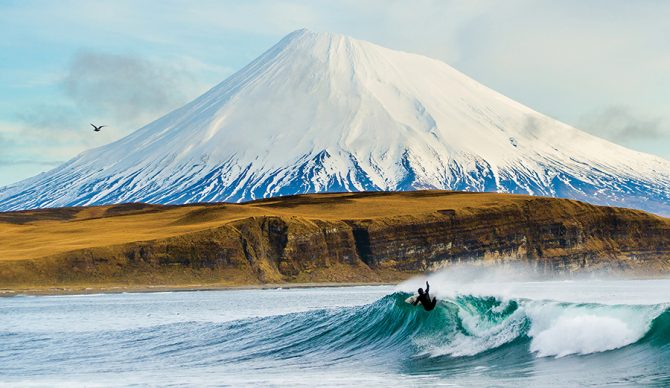
Legendary surfer John Peck made his metabolic transformation last week, and if you’d ever met him, or even encountered him in his latest incarnation, you’d know that he’d probably approve of his passing at age 81 being described in that manner. Suffice it to say that this super-stylish early-to-mid ’60s performer who, after later sliding into a debilitating morass of drug use and criminal activity, reemerged in 1984 relatively intact, and revived his relationship with surfing in decidedly Gandalf fashion — and I don’t just mean the beard. Much like the wizard in The Lord of The Rings, Peck embraced his journey as a spiritual quest, with the gaunt frame, ascetic lifestyle and full-lotus posture to prove it.
Yet for all his various presentations, John Peck will always be best remembered for a single wave; a singular ride. It took place on New Year’s Day, 1963, at the Banzai Pipeline. Ten-to-12 foot out of the west, perfect offshore winds, all the period’s top dogs out, joined by 18-year-old Peck, who only the previous week had surfed Pipeline for the first time. This was the day that Butch van Artsdalen, a talented, rough-and-ready goofy-foot from La Jolla, rode what has long been considered the first modern tube ride, dropping in late on the peak, pulling in under the curl, and emerging triumphant on the shoulder. Establishing a template for every frontside tube-rider to follow, sure, but when viewed in historical context, it was teenaged Peck who gave us our first glimpse of a distant future.
Taking off late backside, rather than dropping straight to the trough and pearling in spectacular fashion, as did virtually every other regular-footer out that day, Peck immediately tucked his back knee to the deck of his board, shifted his front foot to the inside rail, grabbed his outside rail and cranked on it, releasing the fin mid-face, then re-engaging the fin and inside rail at the bottom, he turned his chest toward the shoulder, and with his left arm pointing the way crouched in the shadow of the curl all the way through to a graceful kickout.
Sound familiar? It should — it’s virtually the exact same technique displayed by virtually every skilled backside tube rider today. Especially at Pipeline. So why is it that, unlike van Artsdalen’s example, which by 1968 had become standard performance, the grab-rail backside tube ride took almost 20 years to reemerge into the curl, when Peck’s norm-shattering technique was finally, and effectively, adopted by Hawaii’s Michael Ho’s in his 1982 Pipeline Masters victory?
Weird, isn’t it. I mean, look at the late-sixties shortboard, full wetsuits, leashes, Simon Anderson’s Thruster, tail pads, Tavarua bookings, surf cams — all universally embraced almost immediately following their debut. Which, upon notice of John Peck’s exit from life’s curl and onto its existential shoulder, got me thinking about his very first ‘pig-dog, and of what other surfing innovations and discoveries took so long to go mainstream. For example…
FINS
The vast majority of surfers today accept as essential truth the assertion that a surfboard works much better with a fin(s) on it. Yet this wasn’t always so. Credited with attaching the first crude fin on his hollow paddleboard in 1935, proto-designer Tom Blake exuberantly declared, “My first wave revealed the truth. Never before had I experienced such control and maneuverability.” Inexplicable, really, that at least 10 years passed before even top California surfers finally ditched side-slippery planks for their finned balsa “chips,” and Island watermen retired their finless “Hot Curls.” The truth was in the turn.
INDONESIAN SURF DISCOVERY
Uluwatu in ‘71, Grajagan in ‘72, Padang Padang in ’73, Nias in ‘75 — right off the bat it was pretty damn obvious that Indonesia was holding some of the best waves, and best surfing conditions, on Earth. So please explain why, with very, very few exceptions, nobody thought about exploring the rest of the archipelago for another 15 years. The fabulous right at Katiet (Lance’s) in the Mentawai Islands, for example, wasn’t surfed until 1990, almost two decades after Uluwatu’s discovery. Lazy…or just surfed-out?
POLYSTYRENE/EPOXY CONSTRUCTION
Although early designers Pete Peterson, Bob Simmons and Joe Quigg messed around with polystyrene (Styrofoam) materials as far back as the 1950s, it wasn’t until the early 1980s that a trio of forward-thinking board-builders — Florida’s Greg Loehr, and Californians Clyde Beatty Jr. and John Bradbury — really went all-in on these alternative materials. Bradbury, significantly so. At one point in the late-1980s he equipped virtually half of the domestic Bud Pro Tour’s top-10 with boards made from the material, along with ASP stars like Brad Gerlach and 1989 world champion Martin Potter. It would be fully two decades before polystyrene/epoxy construction became ubiquitous, offered, in some form, by a good number of the surfboard industry’s biggest brands.
SALINA CRUZ
Translated into English, Puerto Escondido means “hidden port.” First charging into the surf mags back in 1977, its heavy, cylindrical beachbreak barrels earned the moniker “Mexican Pipeline.” Since then, the waves of this formerly quiet fishing village hardly remained hidden, but have been regularly featured in the spotlight, these days more than ever. What did remain hidden, however, was a zone of perfectly shaped, perfectly empty, sand-bottomed point breaks located merely a few hours south, photos of which only began to circulate around 1997. Must’ve been the bad roads.
EXITING THROUGH THE BACKDOOR
In 1968, SURFING magazine ran a short article written by Floridian Bruce Valluzzi, featuring Jeff Hakman and friends surfing the rights off Pipeline’s main peak on a small, head-high day, titling the story, “Pipeline’s Back Door.” During the 1971 Golden Breed Expression Session, held in 10-foot Pipeline, regular-foot Sammy Hawk was touted in SURFER’s coverage as, “…the only one to use the backdoor.” But it wasn’t until a dozen years later that, by winning the prestigious Pipeline Masters through the back door, Hawaii’s great Dane Kealoha officially crowned Backdoor as a legitimate, stand-alone surf spot.

NORTHERN LATITUDES
Way back in 1970, SURFER magazine ran a letter from a U.S. serviceman stationed in Reykjavik, Iceland (64.14∞N), reporting that this frigid island country’s rugged coastline actually featured plenty of good waves for surfing. It took 27 years, but SURFER finally responded to the tip, dispatching top photog Jeff Divine and a team of pros to the top of the world, where they indeed rode some pretty fantastic waves. And that’s all it took. Norway, Alaska, the Aleutians…the Cold Rush was on. But in this case, why it took so long probably makes sense to anyone who’s duck-dived in 38-degree water.

